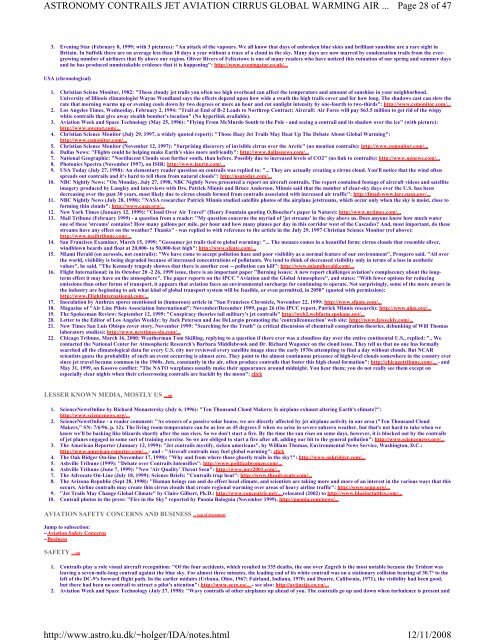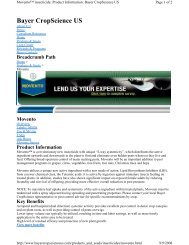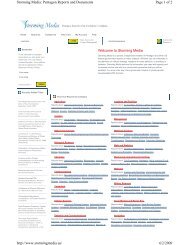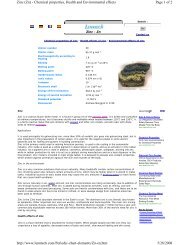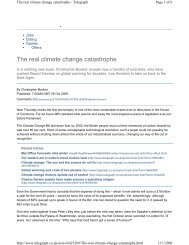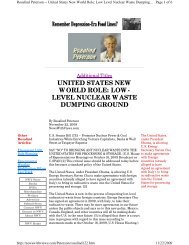of 47 ASTRONOMY CONTRAILS JET AVIATION - Agriculture ...
of 47 ASTRONOMY CONTRAILS JET AVIATION - Agriculture ...
of 47 ASTRONOMY CONTRAILS JET AVIATION - Agriculture ...
You also want an ePaper? Increase the reach of your titles
YUMPU automatically turns print PDFs into web optimized ePapers that Google loves.
<strong>ASTRONOMY</strong> <strong>CONTRAILS</strong> <strong>JET</strong> <strong>AVIATION</strong> CIRRUS GLOBAL WARMING AIR ...<br />
3. Evening Star (February 8, 1999; with 3 pictures): "An attack <strong>of</strong> the vapours. We all know that days <strong>of</strong> unbroken blue skies and brilliant sunshine are a rare sight in<br />
Britain. In Suffolk there are on average less than 18 days a year without a trace <strong>of</strong> a cloud in the sky. Many days are now marred by condensation trails from the evergrowing<br />
number <strong>of</strong> airliners that fly above our region. Oliver Rivers <strong>of</strong> Felixstowe is one <strong>of</strong> many readers who have noticed this ruination <strong>of</strong> our spring and summer days<br />
and he has produced unmistakable evidence that it is happening": http://www.eveningstar.co.uk/...<br />
USA (chronological)<br />
1. Christian Sciene Monitor, 1982: "Those cloudy jet trails you <strong>of</strong>ten see high overhead can affect the temperature and amount <strong>of</strong> sunshine in your neighborhood.<br />
University <strong>of</strong> Illinois climatologist Wayne Wendland says the effects depend upon how wide a swath the high trails cover and for how long. The shadows cast can slow the<br />
rate that morning warms up or evening cools down by two degrees or more an hour and cut sunlight intensity by one-fourth to two-thirds": http://www.csmonitor.com/...<br />
2. Los Angeles Times, Wednesday, February 2, 1994: "Trail at End <strong>of</strong> B-2 Leads to Northrop Contract; Aircraft: Air Force will pay $63.5 million to get rid <strong>of</strong> the wispy<br />
white contrails that give away stealth bomber's location" (No hyperlink available).<br />
3. Aviation Week and Space Technology (May 25, 1996): "Flying From McMurdo South to the Pole - and seeing a contrail and its shadow over the ice" (with picture):<br />
http://www.awgnet.com/...<br />
4. Christian Science Monitor (July 29, 1997, a widely quoted report): "Those Hazy Jet Trails May Heat Up The Debate About Global Warming":<br />
http://www.csmonitor.com/...<br />
5. Christian Science Monitor (November 12, 1997): "Surprising discovery <strong>of</strong> invisible cirrus over the Arctic" (no mention contrails): http://www.csmonitor.com/...<br />
6. Dallas News: "Flights could be helping make Earth's skies more unfriendly": http://www.dallasnews.com/...<br />
7. National Geographic: "Noctilucent Clouds seen further south, than before. Possibly due to increased levels <strong>of</strong> CO2" (no link to contrails): http://www.ngnews.com/...<br />
8. Photonics Spectra (November 1997), on ISIR: http://www.laurin.com/...<br />
9. USA Today (July 27, 1998): An elementary reader question on contrails was replied to: "... They are actually creating a cirrus cloud. You'll notice that the wind <strong>of</strong>ten<br />
spreads out contrails and it's hard to tell them from natural clouds": http://usatoday.com/...<br />
10. NBC Nightly News: "On Monday, July 27, 1998, NBC Nightly News presented a report on aircraft contrails. The report contained footage <strong>of</strong> aircraft videos and satellite<br />
imagery produced by Langley and interviews with Drs. Patrick Minnis and Bruce Anderson. Minnis said that the number <strong>of</strong> clear-sky days over the U.S. has been<br />
decreasing over the past 30 years, most likely due to cirrus clouds formed from contrails associated with increased air traffic": http://fmad-www.larc.nasa.gov/...<br />
11. NBC Nightly News (July 28, 1998): "NASA researcher Patrick Minnis studied satellite photos <strong>of</strong> the airplane jetstreams, which occur only when the sky is moist, close to<br />
forming thin clouds": http://www.caap.org/...<br />
12. New York Times (January 12, 1999): "Cloud Over Air Travel" (Henry Fountain quoting O.Boucher's paper in Nature): http://www.nytimes.com/...<br />
13. Mail Tribune (February 1999) - a question from a reader: "My question concerns the myriad <strong>of</strong> 'jet streams' in the sky above us. Does anyone know how much water<br />
one <strong>of</strong> these 'streams' contains? How many gallons per mile, per hour and how many planes per day in this corridor west <strong>of</strong> the Cascades? And, most important, do these<br />
streams have any effect on the weather? Thanks" - was replied to with reference to the article in the July 29, 1997 Christian Science Monitor (ref above):<br />
http://www.mailtribune.com/...<br />
14. San Francisco Examiner, March 15, 1999: "Gossamer jet trails tied to global warming: "... The menace comes in a beautiful form: cirrus clouds that resemble silver,<br />
windblown beards and float at 20,000- to 50,000-feet high": http://www.sfgate.com/...<br />
15. Miami Herald (on aerosols, not contrails): "We have come to accept pollution haze and poor visibility as a normal feature <strong>of</strong> our environment", Prospero said. "All over<br />
the world, visibility is being degraded because <strong>of</strong> increased concentrations <strong>of</strong> pollutants. We tend to think <strong>of</strong> decreased visibility only in terms <strong>of</strong> a loss in aesthetic<br />
values", he said. "The Kennedy tragedy showes that there is another cost -- pollution can kill": http://www.miamiherald.com/...<br />
16. Flight International: in its October 20 -2 26, 1999 issue, there is an important paper "Burning issues: A new report challenges aviation's complacency about the longterm<br />
effect it may have on the atmosphere". The paper reports on the IPCC "Aviation and the Global Atmosphere", and states: "With fewer options for reducing<br />
emissions than other forms <strong>of</strong> transport, it appears that aviation faces an environmental surcharge for continuing to operate. Not surprisingly, some <strong>of</strong> the more aware in<br />
the industry are beginning to ask what kind <strong>of</strong> global transport system will be feasible, or even permitted, in 2050" (quoted with permission):<br />
http://www.FlightInternational.com/...<br />
17. Inoculation by Anthrax spores mentioned in (humorous) article in "San Francisco Chronicle, November 22, 1999: http://www.sfgate.com/...<br />
18. Magazine <strong>of</strong> "Air Line Pilots Association International": November/December 1999, page 26 (On IPCC report, Patrick Minnis research): http://www.alpa.org/...<br />
19. The Spokesman Review: September 12, 1999: "Conspiracy theories tail military's jet contrails" http://web2.webfarm.spokane.net/...<br />
20. Letter to the Editor <strong>of</strong> Los Angeles Weekly: by Jack Petersen and Joe DeLurgio promoting the 'contrailconnection' web site: http://www.laweekly.com/...<br />
21. New Times San Luis Obispo cover story, November 1999: "Searching for the Truth" (a critical discussion <strong>of</strong> chemtrail conspiration theories, debunking <strong>of</strong> Will Thomas<br />
laboratory studies): http://www.newtimes-slo.com/...<br />
22. Chicago Tribune, March 16, 2000: Weatherman Tom Skilling, replying to a question if there ever was a cloudless day over the entire continental U.S., replied: ".. We<br />
contacted the National Center for Atmospheric Research's Barbara Middlebrook and Dr. Richard Wagoner on the cloud issue. They tell us that no one has formally<br />
searched all the climatological data for every U.S. city nor reviewed every satellite image since the early 1970s attempting to find a day without clouds. But NCAR<br />
scientists guess the probability <strong>of</strong> such an event occurring is almost zero. They point to the almost continuous presence <strong>of</strong> high-level clouds somewhere in the country ever<br />
since jet travel became common in the 1960s. Jets, constantly in the air, <strong>of</strong>ten produce contrails that foster this high cloud formation": http://chicagotribune.com/... - and<br />
May 31, 1999, on Kosovo conflict: "The NATO warplanes usually make their appearance around midnight. You hear them; you do not really see them except on<br />
especially clear nights when their crisscrossing contrails are backlit by the moon": click<br />
LESSER KNOWN MEDIA, MOSTLY US ... up<br />
1. ScienceNewsOnline by Richard Monastersky (July 6, 1996): "Ten Thousand Cloud Makers: Is airplane exhaust altering Earth's climate?":<br />
http://www.sciencenews.org/...<br />
2. ScienceNewsOnline - a reader comment: "As owners <strong>of</strong> a passive solar house, we are directly affected by jet airplane activity in our area ("Ten Thousand Cloud<br />
Makers," SN: 7/6/96, p. 12). The living room temperature can be as low as 45 degrees F when we arise in severe subzero weather, but that's not hard to take when we<br />
know we'll be basking like blizards shortly after the sun rises. So we don't start a fire. By the time the sun rises on some days, however, it is blocked out by the contrails<br />
<strong>of</strong> jet planes engaged in some sort <strong>of</strong> training exercise. So we are obliged to start a fire after all, adding our bit to the general pollution": http://www.sciencenews.org/...<br />
3. The American Reporter (January 12, 1999): "Jet contrails mystify, sicken americans", by William Thomas, Environmental News Service, Washington, D.C.:<br />
http://www.american-reporter.com/... - and - "Aircraft contrails may fuel global warming": click<br />
4. The Oak Ridger On-line (November 17, 1998): "Why and from where those ghostly trails in the sky?": http://www.oakridger.com/...<br />
5. Ashville Tribune (1999): "Debate over Contrails Intensifies": http://www.politicalwomen.com/...<br />
6. Ashville Tribune (June 7, 1999): "New 'Air Quality' Threat Seen": http://www.mrr2001.com/...<br />
7. The Advocate On-Line (July 18, 1999): Science Briefs: "Contrails trap heat": http://www.theadvocate.com/...<br />
8. The Arizona Republic (Sept 28, 1998): "Human beings can and do effect local climate, and scientists are taking more and more <strong>of</strong> an interest in the various ways that this<br />
occurs. Airline contrails may create thin cirrus clouds that create regional warming over areas <strong>of</strong> heavy airline traffic": http://www.sepp.org/...<br />
9. "Jet Trails May Change Global Climate" by Claire Gilbert, Ph.D.: http://www.concentric.net/... relocated (2002) to http://www.blazingtattles.com/...<br />
10. Contrail photos in the press: "Fire in the Sky" reported by Paonia Balognia (November 1999), http://paonia.com/news/...<br />
<strong>AVIATION</strong> SAFETY CONCERNS AND BUSINESS ... top <strong>of</strong> document<br />
Jump to subsection:<br />
--Aviation Safety Concerns<br />
--Business<br />
SAFETY ... up<br />
Page 28 <strong>of</strong> <strong>47</strong><br />
1. Contrails play a role visual aircraft recognition: "Of the four accidents, which resulted in 335 deaths, the one over Zagreb is the most notable because the Trident was<br />
leaving a seven-mile-long contrail against the blue sky. For almost three minutes, the leading end <strong>of</strong> its white contrail was on a stationary collision bearing <strong>of</strong> 30.7° to the<br />
left <strong>of</strong> the DC-9's forward flight path. In the earlier midairs (Urbana, Ohio, 1967; Fairland, Indiana, 1970; and Duarte, California, 1971), the visibility had been good,<br />
but there had been no contrail to attract a pilot's attention": http://www.aero.ca/... - see also: http://avijacija.co.yu/...<br />
2. Aviation Week and Space Technology (July 27, 1998): "Wavy contrails <strong>of</strong> other airplanes up ahead <strong>of</strong> you. The contrails go up and down when turbulence is present and<br />
http://www.astro.ku.dk/~holger/IDA/notes.html<br />
12/11/2008


